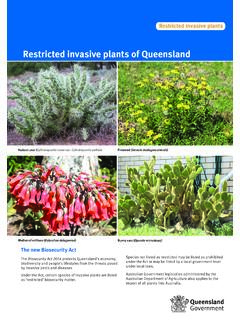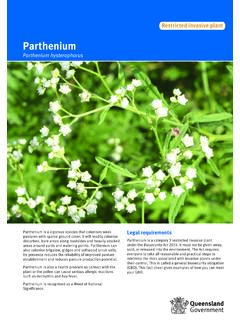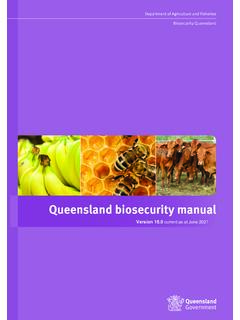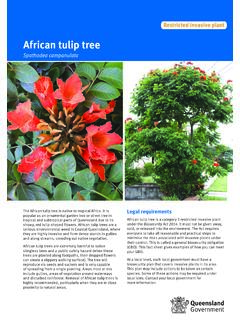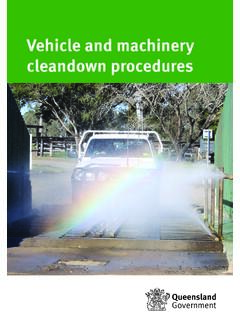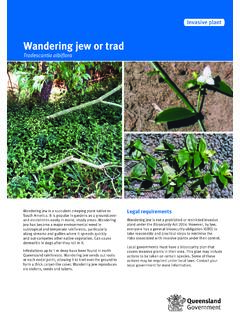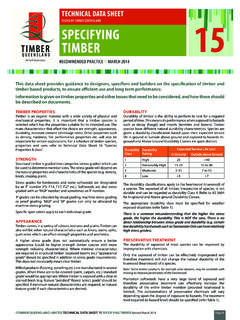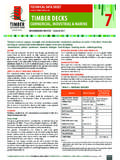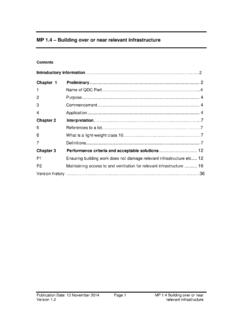Transcription of Rat's tail grasses
1 Rat s tail grasses are invasive grasses that can reduce pasture productivity, out-compete desirable pasture grasses and cause significant degradation of natural areas. They are often referred to as weedy Sporobolus species were originally introduced and trialled as pasture grasses and for soil conservation and have been unintentionally spread from these initial introductions and other accidental introductions as contaminants in pasture seed, fodder, on vehicles and machinery and in and on livestock. Rats tail grasses have now adapted well to large areas of northern, eastern and southern Australia. They have low palatability when mature, are difficult to control and can quickly dominate a pasture, especially following drought, overgrazing or soil disturbance. They can affect cattle health and productivity reducing weight gain and growth rates and weaning percentages and weights. These grasses are a significant threat to the broader environment given they are well adapted to Australia, difficult to control and form dense almost mono-specific stands where conditions allow.
2 Rat s tail grassesSporobolus pyramidalis, S. natalensis, S. jacquemontii and S. fertilisRestricted invasive plant2 Rat s tail grasses Four species of introduced Sporobolus grasses are invasive plants in queensland : giant rat s tail grass (Sporobolus pyramidalis and Sporobolus natalensis) American rat s tail grass (Sporobolus jacquemontii) giant Parramatta grass (Sporobolus fertilis).Legal requirementsGiant, American and giant Parramatta rat s tail grasses are category 3 restricted invasive plants under the Biosecurity Act 2014. A person must not release these invasive plants into the environment, give away or sell as a seed, plant or something infested with its seeds. The Act requires everyone to take all reasonable and practical measures to minimise the biosecurity risks associated with invasive plants under their control. This is called a general biosecurity obligation (GBO). This fact sheet gives examples of how you can meet your a local level, each local government must have a biosecurity plan that covers invasive plants in its area.
3 This plan may include actions to be taken on certain species. Some of these actions may be required under local laws. Contact your local government for more and distributionRat s tail grasses are robust, perennial tussock grasses growing up to 2 m high. They are difficult to distinguish from other pasture grasses before maturity. However, their leaves are noticeably tougher than those of any other can also be difficult to distinguish from native Sporobolus grasses ; however, the native grasses tend to be shorter and softer and have less dense seed heads than giant rat s tail grass. The seeds of all species are indistinguishable in pasture seed samples using current identification rat s tail grassGiant rat s tail grass grows up to 2 m high, with a seed head of up to 45 cm long and 3 cm wide. Seed head shape changes from a rat s tail when young to an elongated pyramid shape at maturity. Unlike Parramatta grass and giant Parramatta grass, giant rat s tail grass does not develop sooty spike on its seed : Coastal and sub-coastal areas from Cape York ( queensland ) to the Central Coast of New South Wales including the Central Highlands of rat s tail grassAmerican rat s tail grass grows to 50 75 cm tall, with a seed head of up to 25 cm long and 3 cm wide.
4 Distribution: Coastal and sub-coastal areas from Cape York to South East Parramatta grassGiant Parramatta grass grows to m tall, with a seed head of up to 50 cm long and 1 2 cm wide. The branches of the seed head are pressed against the axis and overlap, although lower ones generally spread at maturity. Distribution: Coastal and sub-coastal areas from Cape York to South Coast of New South cycle and adaptationRat s tail grasses flower and seed in the frost-free period of the year, with the main seeding in summer/autumn. They are prolific seed producers with seed production of 85,000 seeds per square metre recorded in dense stands of giant rat s tail grass in a single year. The viability of rat s tail grass seed is about 90% with asignificant proportion of seed remaining viable for up to 10 s tail grasses are well adapted to a wide range of soils from low to high fertility, acid to alkaline and sandy to heavy clay soils in high and low rainfall locations.
5 This includes the seasonally dry monsoonal tropics, wet and dry tropics, subtropical and temperate regions of Australia. They also tolerate saline soil conditions. Methods of spreadRat s tail grasses are spread in the gut and manure, and the coat and hooves of livestock, on the coat of invasive and native animals and in mud, hay, and untested pasture seed. Vehicles and machinery are also important spreaders of seed. Rivers, watercourses and any fast-flowing water can also move significant amounts of seed over long distances particularly where there are low levels of ground cover. ControlManaging rat s tail grassesThe GBO requires a person to take reasonable and practical steps to minimise the risk of spreading rat s tail grass seed and the establishment of new infestations. This fact sheet provides information to assist with minimizing spread and a summary of options for controlling rat s tail and early detectionMaintain competitive pastures with high levels of ground cover as this reduces the risk of rat s tail grass establishment.
6 Heavy grazing does not control rat s tail grasses research indicates that continuous heavy grazing actually favours its moving stock from infested areas into clean areas, spell the stock in yards or a small holding paddock for at least seven days to allow rat s tail grass seed to pass thought the gut of the animal. Similarly, quarantine new stock in yards or small holding paddocks before releasing them into large paddocks to minimize the risk of rats tail grass seed spread and enable early detection and control of any rat s tail grass plants that establish. Move stock when there is no dew or rain, to decrease the amount of seed sticking to their coats (see Table 1).Establish weed-free buffer strips along boundary and internal fences where necessary, drainage lines and roadsides to restrict the spread of rat s tail grasses . When practical, regularly controlling rats tail grasses in riparian zones will reduce the movement of seed by water and limit spread.
7 Always clean machinery thoroughly after working in infested areas. Follow integrated control strategies using herbicides, pasture management practices that maintain high levels of ground cover and property hygiene practices that limit the risk of seed spread. Consider the attributes of replacement pasture grasses when deciding what to sow. If possible, choose grasses that are: Rat s tail grasses 3 well adapted to local environmental conditions and soil types stoloniferous or rhizomatous in growth habit resistant to heavy grazing palatable and productive competitive all year ( do not open up in late winter/spring) not inclined to decline as soil fertility decreases fast to a sown pasture species does not contain most of these attributes, it is unlikely to be successful as part of a rat s tail grass control pasture species, while providing strong competition once established, are weak competitors with rat s tail grasses in their early stages of establishment ( Koronivia grass and Bisset creeping blue grass).
8 These grasses are most successful against rat s tail when sown with other grasses that are vigorous when young and provide early competition against rat s tail grasses ( Rhodes grass). Biological controlBiosecurity queensland is investigating potential biological control agents. To date no agent has been approved for the control of rat s tail strategiesAlways commence control programs in areas of light infestation, and work towards the denser , after considering the management options set out below, you choose to use a herbicide option, ensure you apply all herbicides strictly according to the directions on the label and the directions of any Australian Pesticides and Veterinary Medicines Authority (APVMA) permit. You must read APVMA permit 9792 if you wish to prepare or use products for the control of rat s tail grasses in situations other than those specified on the product herbicides permitted or registered for giant rat s tail grass control have withholding periods and significant ongoing management requirements in grazing and dairy farming.
9 If you have or may have dairy or beef cattle on your property at any stage in the future, carefully consider these requirements when choosing herbicides for use on your details of management options are provided plants and light infestationsChoose one of the following options:(a) spot spray with glyphosate (b) spot spray with flupropanate (c) use glyphosate through a pressurised wick wiper (d) hand chip, bag and remove stools from the paddock and burn infestations on arable land(a) Cropping optionFirst summer (early)1. Boom spray with glyphosate as per label or permit directions and burn prior to ploughing. 2. Spot spray or hand chip fence lines, headlands, drainage lines, shelter belts etc. for weedy rat s tail grasses missed in cultivation. Plant a long-season forage sorghum variety using a recommended pre-emergent herbicide. 3. Spot spray or hand chip any surviving rat s tail grasses to prevent summer1. Boom spray with glyphosate to control new seedlings and crop regrowth prior to cultivation.
10 2. Follow the same procedures and similar cropping as for the first summer1. Boom spray with glyphosate to control crop regrowth and any rat s tail grass seedlings. 2. Plant paddocks with improved pastures using minimum tillage techniques to restrict bringing buried seed to the surface. Use a direct drill planter or surface broadcasting and rolling techniques. Plant fast-growing pasture grasses at triple the standard sowing rates to compete with rat s tail grass seedlings. 3. Fertilise the pasture for fast pasture establishment. 4. Spot spray or hand chip rat s tail grass seedlings.(b) Pressurised wick wiper optionTo be effective, this option requires three treatments over an 18-month treatment (midsummer)1. Make sure there is a 30 cm height difference between rat s tail grasses and other pasture plants by selective grazing of the good pasture. 2. Wick wipe rat s tail grass using glyphosate as per label or permit directions.
